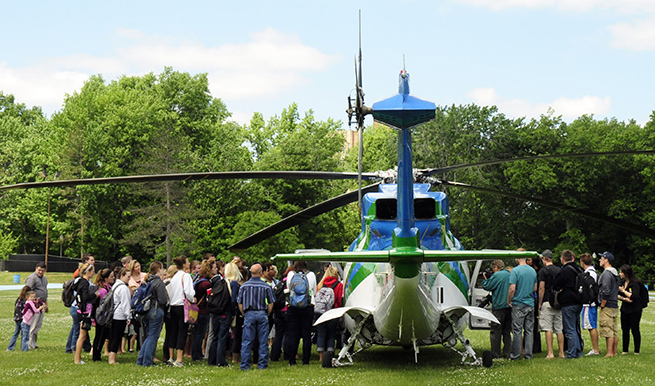Cleveland Clinic flight crew lands at Kent State for demonstration
June 4, 2013
A group of students, professors and community members gathered for a hands-on tour of one of Cleveland Clinic’s medical helicopters on Kent State’s track on Monday, June 3, 2013.
About 40 nursing students from the accelerated program gathered by the track behind Henderson Hall with phones and cameras ready to take pictures of the approaching medical helicopter from the Cleveland Clinic Critical Care Transport Monday.
The helicopter landed in the grassy center of the track as part of a demonstration organized by Cathy Snelson, associate lecturer in the College of Nursing, to show students the process of being a flight nurse.
“They see what it takes, first of all, to coordinate a landing,” Snelson said. “So that, regardless of whether these guys land at an emergency scene or doing hospital to hospital transporting, there’s a lot that has to go on behind the scenes to make that happen. I think it allows them to appreciate the multidisciplinary role here that we got to have skilled pilots as well as healthcare professionals on board. And then they get an opportunity to actually see the working space where this level of care transpires.”
Snelson received comments from students who were interested in this career path, including her daughter, Erin Stefanik, senior nursing major.
“I never really thought about the different careers,” Stefanik said. “I just always thought there was like bedside nursing, and so before I got into the program, my mom was like telling me about the different kinds of nursing there are.”
Stefanik then told her mom that she could arrange activities and demonstrations like the helicopter landing or viewing a surgery to show students that nursing is not just working in a hospital by a patient’s bedside.
Snelson, who used to be a field triage nurse in Kentucky, coordinated the visit with Ellen Prewitt, a member of the flight crew at Cleveland Clinic. The medical helicopter landed in the track by Henderson Hall for the first time since 2001.
Before the helicopter landed around 12:30 p.m., Prewitt gave a presentation to the students about what a flight nurse does and talked specifically about what the Cleveland Clinic does. She said Cleveland Clinic flight nurses have traveled to more than 22 different countries and more than 42 states to transport patients. The clinic also has a jet, which is used to travel distances more than 250 miles.
“If you figure, if we took the helicopter all the way down to Florida, we would have to make, I think they said, seven to 10 stops,” Prewitt said.
Michael Kaffel, acute care nurse practitioner on the flight team, has been working with the Cleveland Clinic for about a year. He said his job is challenging, and flight team responsibilities are for nurses who are calm under pressure.
“You have very limited resources even though we have a lot of equipment,” Kaffel said “You don’t have space a lot of times, which you take for granted. And it’s loud and hot. Or it’s really cold if you’re at 5,000 feet coming from New York in the dead of winter.”
Prewitt told the students that the clinic offers students a chance to observe the flight nurses in action, and senior nursing majors Pete Araps and Chad Crouch got two contacts to observe a transport.
Crouch said being a flight nurse has crossed his mind and that the presentation gave him more of an idea of what it involves.
Araps said the job competition is intense — a flight crew member told him about 50 people out of hundreds get interviewed — and was surprised by how small the helicopter staff was.
“Basically it’s a doctor and a nurse saving this person, keeping them alive until they get there,” Araps said. “It’s like you have to know your stuff because if something else goes wrong, I mean, who are you going to rely on? You can’t call for backup.”
Contact Alicia Balog at [email protected].












